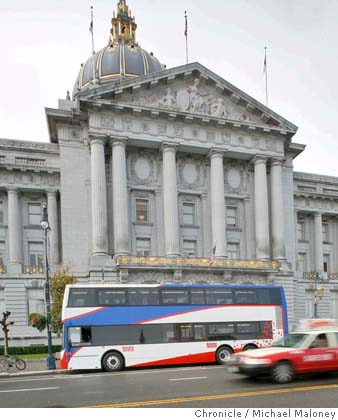San Francisco tests double decker bus
In the U.S., only the bus system in Las Vegas runs double decker buses. In Canada, so does Victoria, BC. Community Transit in Snohomish County, Washington has tested such a bus. And DC1974 alerts us to San Francisco's testing such a bus currently, before it is delivered to Las Vegas.
(Yes, we are not talking about tourist buses, but regular in-service buses intended for public transportation usage. The Alexander Dennis bus is the same used in most of the tourist bus applications. Van Hool, the same company that produces the buses used for the Circulator, also manufactures double decker buses.)

Before the publicity tour, the 40-foot-long, 14-foot-tall bus, on loan from the manufacturer, Alexander Dennis Ltd., was parked outside City Hall. Chronicle photo by Michael Maloney
See "Look for this bus around town, minus the mayor," from the San Francisco Chronicle.
Despite subway riders in the suburbs believing that they are second class citizens despite the extremely high quality of their ride, the fact is that bus riders are the true second class transit riders in the DC region.
One way to reposition how buses are perceived is to change the type and quality of the buses. Another advantage of such buses is that they take less space than 60 foot articulated buses. (Loading times may increase slightly.)
Certainly on higher usage bus lines--30s, 90s, X, 70s--by increasing the capacity of buses, quality of service and the number of people able to be transported could increase and improve service.
Labels: transit, transit marketing



0 Comments:
Post a Comment
<< Home